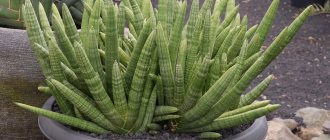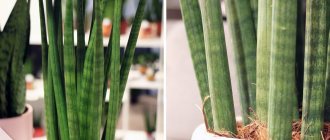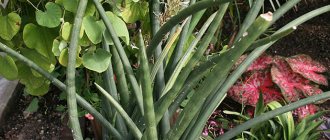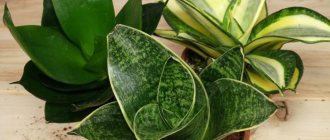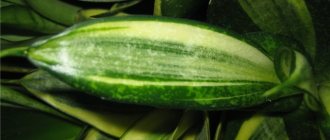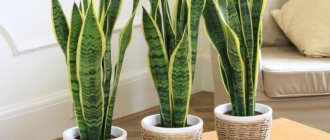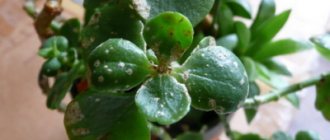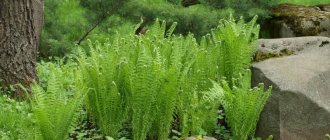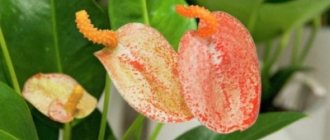Sansevieria or Sansevieria is one of the champions in oxygen production among houseplants; at the same time, this plant absorbs substances harmful to health from the air. For its striped, hard and long leaves, Sansevieria has received the popular name “pike tail”. Sansevieria is unpretentious in care and is successfully grown by novice gardeners. This plant is very decorative, looks impressive indoors, and is often grown at home, in offices and winter gardens.
Mother-in-law's tongue flower - description
Sansevieria, according to various sources, belongs to the Agave or Asparagus family. The genus Sansevieria contains about 60 species. In nature, representatives of the genus can be found in the subtropics and tropics of Africa, Asia, America and Madagascar.
Sansevieria is a herbaceous plant with long, erect leaves. In most species, leaves grow directly from the rhizome, some have a small shortened stem. The leaves reach a height of 60-150 cm. They are collected in small rosettes of 3-13 pieces. The shape of the leaves is xiphoid, pointed. The surface of the plate is painted in different shades of green and decorated with zigzag horizontal stripes of a darker color. The edges of the leaves in some species are decorated with a light or yellow frame.
How pike tail blooms
With sufficiently bright lighting, Sansevieria may have a flower arrow appear from the center of the leaf rosette. The flowers are collected in paniculate inflorescences; the buds themselves are small, white and fragrant. During the flowering period of Sansevieria, the rooms of the house are enveloped in the delicate aroma of vanilla. After flowering ends, the leaf rosette from which the flower branch appeared dies off completely.
Sansevieria - benefits and harm for the home
Sansevieria is considered not only one of the simplest, but also useful plants. It can even be placed in a children's room or bedroom. The green parts of Sansevieria perfectly absorb harmful compounds from the atmosphere, saturate the air with oxygen, and destroy bacteria.
Mother-in-law's tongue is often used in folk medicine and is considered a real home healer. It is used to treat wounds, burns, headaches, otitis media, diseases of the gastrointestinal tract and normalize blood pressure. Despite its widespread use and many beneficial properties, Sansevieria should be used wisely and only for external use. Otherwise, plant-based preparations can cause poisoning, vomiting, severe allergic reactions and intestinal disorders.
The hard leaf plates of Sansevieria are not very attractive to children, and breaking them may not be so easy, but you should not allow children and family members to break, chew or tear off the leaves of the plant. The juice of this flower, when it comes into contact with mucous membranes, causes poisoning and vomiting.
Home benefits of Sansevieria
- This indoor plant is valued by many gardeners for its decorativeness and unpretentiousness.
- Many believe that mother-in-law's tongue, like cacti, absorbs harmful radiation from a computer
- It is believed that mother-in-law's tongue protects against colds, alleviates the condition during sudden changes in weather conditions, and even helps to more easily survive difficult life situations.
As we have already noted, Sansevieria is a rather unpretentious plant, so caring for it is not at all difficult.
Caring for Sansevieria at home
Caring for Sansevieria is very easy. This plant is incredibly hardy and almost does not suffer from harmful external influences.
Lighting
Sansevieria grows well both in a dark corner and on a light windowsill. As a rule, good lighting is the key to flowering of this plant. In a dark corner, variegated species can take on a monochromatic, simple color, so it is better to place them closer to the light source. Sansevieria should be protected from the scorching sun, otherwise brown burns will begin to appear on it.
Temperature and humidity
At home, potted Sansevieria can survive in a fairly wide range of temperatures and does not need special conditions. In summer, a normal temperature of about +18-+250C is suitable for keeping, and in winter it is better to put the pot in a cool, bright place and keep it at a temperature of about +14-+160C.
It is not recommended to allow the temperature to drop to +100C or lower, otherwise Sansevieria may freeze. In general, “Mother-in-Law’s Tongue” tolerates drafts and sudden changes in temperature well, but prolonged negative effects can lead to very disastrous consequences.
Most Sansevieria species come from dry regions, so they grow much better in low humidity. It is recommended to periodically wipe Sansevieria from dust with a damp cloth or napkin. In particularly hot weather, you can also spray it with warm water from the shower or spray it with a spray bottle. After the procedure, be sure to blot the sockets with a dry cloth and remove any moisture that has accumulated in them.
Watering
Water for irrigation is stored 1-2 days in advance so that it has time to sit at room temperature and become softer. When watering, do not allow moisture to get into the center of the outlet.
In summer
In the warm season, watering should be moderate. The soil in the hill is moistened in small portions about once a week.
in winter
From autumn to the end of winter, the soil in the pot is moistened approximately 1-2 times a month. The substrate should not be allowed to dry out completely between waterings, so if Sansevieria has drooped, it is better to slightly moisten the earthen ball.
Fertilizer
Special fertilizers for cacti are used as an additional source of nutrition. The frequency of feeding is once a month, only the dosage is reduced by half. Fertilizers are applied to the soil along with watering from spring to September.
general description
Sansevieria, or sansevieria, belongs to an evergreen stemless plant of the Sprazhev family (in some catalogs the name Agave appears). Many species and varieties of sansevieria can be found in the dry, rocky regions of the subtropics and tropics, in Africa, Indonesia, South Florida, India, and Madagascar.
Various types of Sansevieria
The name Sansevieria comes from Latin in honor of the name of the Neapolitan prince Sansevierio. He developed and actively promoted natural sciences.
Other names for the plant:
- Cuckoo's tail - due to its long stem,
- Baseball bat - due to the fact that the leaves are hard and strong, they can hit like a bat,
- Leopard lily - due to its bright color,
- Compacta - especially characteristic of the low-growing variety of the Laurenti plant (the leaves curl, the stems seem to be trying to braid),
- Snake plant or skin - thanks to the yellow lines on the leaves, reminiscent of the color of a snake,
- Devil's tongue
- African hemp.
Sansevieria flower is popular in the interior. Designers often decorate rooms with them and use them to create compositions.
This plant can behave quite unpretentiously, since it is characterized by strong vitality. As a rule, it is difficult to destroy, it always pleases with its bright foliage and does not dry out even if you do not approach it for a month or a month and a half.
Description of Sansevieria:
- Is it possible for Sansevieria to bloom? This question is relevant among flower growers. For many, the answer is clear: she doesn’t have flowers. Sansevieria can bloom as an ornamental foliage plant. Thanks to proper care at home, the leopard lily is covered with inconspicuous flowers. However, only a professional can visually identify them.
- Reproduction occurs by cuttings or dividing the rhizome.
- Temperature. Tolerates room temperature well.
Important! If the temperature drops below 16 degrees in the room, the plant dies.
- Lighting. Loves partial shade or bright light, but diffused.
- Watering should be moderate but systematic.
- Feeding. Fertilizer is introduced at the time of active growth, once a month. You can use cactus fertilizer.
- Transplantation is done individually when the rhizome is strongly developed.
- Harmful insects and diseases. Sansevieria can be damaged by root rot and anthracnose, thrips and spider mites.
Reproduction
At home, you can try growing Sansevieria from seeds, cuttings and leaves. Any part of this plant can successfully take root and become part of your home collection.
Leaf
Whole leaves or parts thereof, cut horizontally, are used as cuttings. In order for part of the leaf to take root successfully, it must be about 4-5 cm high; it is also necessary to immediately mark the top and bottom, otherwise a cutting planted upside down simply will not take root. Before planting, Sansevieria is dried for several hours, then rooted in wet sand. The cuttings are placed in the substrate at an angle of 450 and covered with a jar or plastic bag. As a rule, after 1-1.5 months the cuttings take root and grow, after which the seedlings can be transplanted into the substrate.
Cuttings
Daughter rosettes are used as cuttings, which can be separated during transplantation. They are cut off from the rhizome and planted in separate pots. Only developed shoots are planted, with their own growing point and roots. Before planting in a new pot, the cuttings are slightly dried and treated with charcoal.
Seeds
Sansevieria seeds germinate well and amicably, but they cannot be obtained at home. Sow seeds in wet sand or peat-sand mixture. The top of the dishes is covered with film, and the substrate is moistened as needed through a tray.
It may take several weeks or even months before the first shoots appear, so the owner may need a lot of patience. After the seeds hatch, they grow actively and after a month they are ready for picking.
Peculiarities
Sansevieria, better known as Mother-in-Law's Tongue, also called Pike Tail, is a popular indoor flower. Depending on the type it may look different. Designers actively use its attractive and unusual appearance in the interior of the apartment.
Country of origin Africa, Madagascar and South Asia. It is a hardy plant with leaves that can reach a height of several tens of centimeters.
Sansevieria produces flowers, but they are tiny, so the plant is loved more for its rich green foliage. The inflorescences are collected in small bouquets on long stems or racemes, the berries appear after. In their native habitat, flowers are pollinated by moths.
When grown indoors, they do not produce seeds because there are no natural pollinators.
Sansevieria can be grown from seeds, but more often it reproduces through underground rhizomes. Low-growing species do not produce many suckers, while others spread very aggressively and can become invasive in the landscape if grown in a tropical area.
Some species may have white-edged or yellow-striped leaves and tiny light green fragrant flowers. This is a stemless perennial plant. It can bloom in summer or autumn, but very rarely at home. Many species have tough, fibrous foliage, which is sometimes used in rope and bowstring.
Wide leaves need to be wiped regularly so that the plant can “breathe” . This is one of the best air purifiers that removes toxins like formaldehyde, xylene, and toluene.
This plant is poisonous, therefore, if it enters the gastrointestinal tract, it causes unpleasant symptoms such as vomiting, diarrhea, and nausea. This applies not only to people, but also to animals, who often try to chew the leaves, so it is advised to keep the flower away from the floor, out of the reach of children and pets.
Transplanting Sansevieria
Sansevieria does not require frequent transplants. This plant feels best in a cramped pot, so even young specimens are replanted once every 2 years, and adults even less often. When the roots of the plant begin to protrude from the drainage holes, this means that it is time to choose a new pot for Sansevieria.
Priming
The soil for planting should be light and breathable. You can purchase a special substrate for cacti in the store or mix 2 parts leaf soil, 1 part sand and 2 parts turf soil. It is advisable to mix a little brick chips, pieces of coal, coarse sand or perlite into the prepared soil.
Pot
It is desirable that the planting container be wide and stable, with a sufficient number of drainage holes, 1-2 cm larger than the previous pot. You can choose a pot from any material, but it must be strong, since the roots of the plant can easily deform or break dishes with thin soft walls. The ideal choice would be a pot made of clay, ceramics or even a wooden planter for very large Sansevierias.
Diseases
It is not for nothing that Sansevieria is called one of the most tenacious plants. She is very resistant to negative influences and very rarely gets sick. If the rules of care are violated, some difficulties may arise. It is important to recognize them in time.
Problems with leaves
Mother-in-law's tongue can react to strong changes, and its leaves often suffer. The following signs indicate that the plant is not comfortable:
- Turn yellow - cramped pot, lack of light.
- Drying tips - excessive watering, poor lighting.
- Curl - most often the cause is poor watering.
- Sluggish - the earthen ball is dry and needs watering. Even if the plant does not recover after watering, and the base of the flower becomes soft, this may indicate a rot disease.
- Falling apart (falling) - long, brittle leaf plates that cannot maintain a vertical position and fall apart indicate insufficient lighting. Then Sansevieria grows disproportionately long and falls apart. You need to move the pot closer to the light source and then the new leaves will grow normal and strong. The bush can be temporarily tied with thin twine or soft rope.
- Brown spots have appeared due to cool conditions and excessive watering. You need to move the flower pot to a warmer place and reduce watering.
- If it develops poorly or does not grow at all, Sansevieria grows better in a cramped pot, so if after replanting the plant has stopped growing for several months, then there is no need to worry. Also, Sansevieria does not need to grow actively with regular, abundant watering. Therefore, if you slightly reduce the amount of moisture, new leaves will soon begin to appear from the rosettes.
Sometimes, with excessive watering, cool maintenance, or moisture getting inside the leaf rosette, rot may appear. Therefore, you need to water Sansevieria carefully, trying not to get water on the leaves and rosettes. To save Sansevieria, it is taken out of the ground, washed, damaged parts are removed, then dried and treated with charcoal. Afterwards, you can plant the plant in a new substrate.
Sansevieria diseases
Anthracnose. It appears on the leaves in the form of small depressed brown spots. If measures are not taken in time, the spots will begin to increase and the leaf will dry out.
The affected plant is removed from the pot. Wash the leaves and roots in a pink solution of potassium permanganate. Then they are transplanted into fresh soil, sprayed with a solution of Fitosporin-M and the soil is watered with it. The surface of the soil is sprinkled with coarse sand.
Root rot . This disease leads to rotting of the roots and bases of leaves. It is difficult to treat, so it is better to take care of prevention - moderate soil moisture and protection from pests.
At the first signs of disease, transplant the plants into fresh soil, cutting out the damaged areas and disinfecting the pot.
Fusarium. It manifests itself in the fact that small watery spots appear on young leaves of Sansevieria. Gradually they grow and change color to red.
If action is not taken quickly, the plant will die. It is urgent to replant it in fresh soil, after washing the roots and disinfecting the pot. Cut out all sore spots with a sharp knife and treat the sections with Fukortsin or brilliant green. Adjust temperature, light and watering. Spray plants with Fitosporin-M solution 2 - 3 times with an interval of 10 days.
Pests
Sansevieria is very rarely attacked by pests. The leaves of the plant are too hard and covered with a thick waxy layer, so you can easily get rid of unwanted insects.
Red tick
Red mites are quite rare. It attacks growing points and hides in the axils of leaves. If pests are detected, it is necessary to treat with systemic acaricides, for example, Oberon.
Spider mite
You can get rid of spider mites using a soap solution; wipe all parts of the plant with it. In case of severe damage, you can treat the flower with Actellik.
Thrips
Thrips form colonies on the underside of the plates, while they lose their rich color and fade. To save the flower, you need to carry out several treatments with Actellik or Fitoverm.
Mealybug
If the plant is twisted or yellowed, this may be a sign of a mealybug. The parasite is removed in several stages: first, the plant is treated with a dry cloth, and then all its parts are sprayed with Karbofos.
Shchitovka
You can get rid of scale insects using a damp sponge. Parasites are removed manually, and then treated with Actellik, Karbofos or Fitoverm.
Pests: identification and destruction
Sansevieria can be affected by various pests. The most common are :
- spider mite;
- thrips;
- mealybug;
- scale insect
Sansevieria not only decorates the interior of a living space or office, but also purifies the air well. On our website you will find articles on how to propagate “mother-in-law’s tongue,” as well as recommendations for caring for the plant.
Spider mite
Spider mites appear as whitish spots on the leaves . The leaves turn yellow and fall off due to the fact that the pest feeds on the juices of sansevieria. The ideal conditions for the existence of spider mites are rooms with dry air and insufficient watering.
To avoid this, it is necessary to regularly ventilate the room and do not forget to water the plant.
If the infection is at the initial stage, treatment of the flower is reduced to wiping its leaves with a cloth previously soaked in an infusion of citrus peel. In more severe cases, the plant is treated :
- insectoacaricides;
- acaricides.
The drugs need to be alternated, as repeated treatment is less effective. The interval between treatments is 5-7 days.
Thrips
You can identify a thrips infestation by carefully examining the lower parts of the leaves. This is where colonies of thrips larvae live. On the outside of the leaf you can notice the appearance of light spots. The leaf changes its usual color to grayish-brown with a silvery sheen .
Treatment of the flower consists of treating it with insecticidal preparations.
For example, if you use Actelik, then after treating the plant with Actelik solution, in the proportion of 1 ampoule per 1 liter of water, the sansevieria should be wrapped in a bag for one day to increase the effect.
Mealybug
Mealybug infestation is very easy to detect; it leaves cotton-like lumps on the leaves, which are waste products of the pest.
The insect is localized at the base of the leaf rosette and feeds on sansevieria juice. The affected parts of the plant may change shape and color.
To carry out treatment, you need to remove the pest manually and wash the leaves with a cloth soaked in soapy water. In case of more serious damage, the plant is treated with insecticidal preparations once a week until it disappears completely.
Shchitovka
Scale insects manifest themselves by laying eggs, which can be found on the back of the leaf. The insect eats the shoots of the flower and drinks the juice from it . Treatment is performed by removing scale insects with a swab dipped in a soap solution. Sansevieria is then treated with insecticidal preparations.
Important! Scale insects have a shell, which makes it difficult to get rid of the pest, so treatment must be carried out several times a week until it disappears completely.
When using insecticidal preparations, you should adhere to the conditions specified in the instructions and not overdo it, because their excessive use can harm not only the plant, but also humans.
All diseases of Sansevieria can be dealt with . Of course, it is better to prevent any of them in advance than to urgently hospitalize the plant in the future, carry out treatment and rescue. In any case, every gardener should know by heart the symptoms of various diseases and the methods used to restore the health of the flower.
Sansevieria - popular species with names and photos
There are several varieties of Sansevieria that have found a home in modern homes and are popular with gardeners and collectors.
Three-lane or Trifasciata
The most recognizable species with sword-shaped leaves, dark green with transverse stripes and yellow edging.
Moonshine
An exotic plant with wide oval leaves growing directly from the ground. The leaves are smooth, about 30-35 cm high, collected in rosettes of 5-6 pieces. The leaves are dark green with a bluish bloom, giving the surface of the plates a light green dusty color.
Laurenti (Laurentii)
The leaves are grayish-green, erect, long and narrow. The bush grows up to 1 m in height. The surface of the leaf is decorated with stripes and a light frame along the edge.
Hanny
Sansevieria with short, almost horizontal, green, bluish or gray leaf blades. The surface of the plates is decorated with horizontal light or dark stripes.
Futura
A low-growing variety up to 30 cm high. The leaves are collected in dense rosettes of 12-13 pieces. The surface of the leaf is juicy green with a yellow edging.
Robusta
The leaf blades are wide, short, decorated with horizontal stripes of dark green color.
Golden flame
The leaves are yellow-green and elongated. They are bright yellow above and green below with a golden frame.
Twister Sister
Low-growing Sansevieria with curly leaves that are located almost horizontally to the soil. The plates are bright green with characteristic stripes and a light yellow wide stripe along the edge.
Whitney
Grows up to 50 cm in height. The leaf blades are wide, xiphoid, collected in rosettes of 4, have a wide dark green stripe in the center, and two-color stripes along the edges.
Black Gold
A variety with dense rosettes and light green leaves. The surface of the plate is decorated with horizontal dark stripes and yellow edging. The leaves are long, narrow, and have a bluish tint.
Black Coral
Grows up to 1 m in height. The foliage is lanceolate, dark green with transverse light, dark and grayish stripes.
Cylindrical or Cylindrical (Cylindrica)
This Sansevieria is perhaps the most unusual of all the others. Its leaf blades are not flat, but twisted into straight cylinders that can grow up to 1.5 m in height. The color is dark green with transverse stripes. An interesting feature of this species is its flexibility, the ability to take any shape.
Bonselensis
The leaves are voluminous, cylindrical, folded into a double-row rosette and arranged like a fan. The color is gray-green, with transverse dark green stripes.
Bacularis
The leaf blades are cylindrical, twisted into a tube, bright green with dark green stripes.
Zeylanica
Grows up to 1.5 m in height. The leaf blades are dark green with many yellowish, light green and white stripes.
Mikado
Sansevieria with thick cylindrical plates and dark transverse stripes.
Masoniana
It grows quickly and reaches 1 m in height. The leaves grow singly and curl into spirals and are bright green with a mottled pattern.
Samurai
The leaf blades are short, fleshy, grayish-green in color, fanned into rosettes opposite each other. There is a groove running through the center.
Pick
The leaf rosette consists of several erect green plates. The surface of which is decorated with light specks in the form of a brown-red stripe.
Star Canary
Wide and short leaves are folded into beautiful open spiral rosettes. The leaf blades are beautifully curved and painted a soft yellow with a bright green tip.
Metallica
A rare collectible variety with long silvery foliage. The surface of the plates is decorated with vertical creamy-white stripes. Grows up to 60 cm in height.
Grandis or Big
A species with wide and long leaf blades up to 1.5 m high. The leaves are green with dark zigzag stripes. A reddish border runs along the edges of the plates.
Black Dragon
A low-growing variety with a dense spiral-shaped rosette and wide, pointed leaf blades. The leaves are shiny, smooth, from dark green to almost black.
Mother-in-law's tongue flower: signs and superstitions
It is believed that Sansevieria is capable of absorbing negative energy and extinguishing conflicts in the family. As a result, peace, tranquility and understanding come to the house.
Mother-in-law's language has a special influence on students. It helps to solve even complex problems and overcome learning difficulties.
At home, such a flower is a powerful protector against the evil eye, damage and other bad influences. It takes away illnesses, improves mood, helps fight laziness and apathy.
Photos in the interior
In the house, Sansevieria becomes not only a decoration, but also a useful green pet that will create a pleasant, cozy atmosphere.
